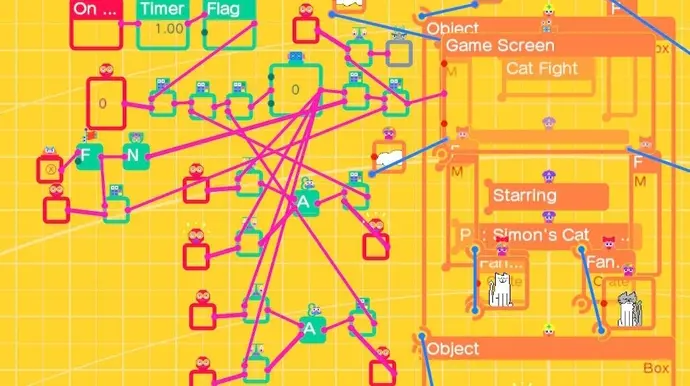
The idea behind Game Builder Garage seemed intriguing when I first saw it in person last month: here’s an opportunity to take a close look at how Nintendo makes its games and perhaps even understand some of the magic and wonder that have made its products so adored worldwide. I’ve spent about twelve hours with it, and the most important thing I’ve learned is that creating video games is very labor-intensive.
Thankfully, it seldom seems all that much like work. Gamers who have experienced Nintendo Labo, of which Game Builder Garage is a logical continuation and builds upon the success of Toy-Con Garage, will recognize the thrill that occurs when Nintendo injects its own style into something so routine. Back then, we all wondered if Nintendo would only focus on Ikea manuals after seeing flatpack instructions brought to life on the Switch’s screen and translated to cardboard. Now, though, Nintendo is offering the most wholesome, approachable, and enjoyable software tutorial I’ve ever come across.
Additionally, it is mostly a software instruction. Game Builder Garage is divided cleanly into two sections, into which you will be thrust right into the first. To access the second section, which consists of freestyle programming, you must first finish the first seven courses. These classes are also essential to get even a rudimentary understanding of what may be accomplished when you are gradually exposed to the highly interactive, visual programming language of Game Builder Garage.
It’s also extremely Nintendo, with all the features you have access to (characters, timings, inputs, and so on) actually brought to life as anthropomorphized blocks called Nodons, each chatting away with a distinct personality. To create a game, all you have to do is put them all together correctly so that your creations end up looking like a thick spaghetti of Nodon and the threads that link them.

When I say simple, what I really mean is that it may be really complicated. To restate, the lessons are crucial to advancing in Game Builder Garage. In fact, these lessons constitute the game itself; they range in duration from 40 minutes for the first to 90 minutes for the final, and each one culminates in a finished game that you may play. After each one, there are brief interactive tests to make sure you’ve retained the information and remove any guidance when you’re asked to put a feature into practice.
Although it might be severe at times, Game Builder Garage is a great instructor. Lessons only allow one desired path to be taken; there is little room to find other routes for any given outcome. Because of this fussiness, some of the ensuing quizzes become trial-and-error exercises as you try to figure out the precise solution that Game Builder Garage is looking for. It may be really annoying at times.
Nonetheless, the outcomes might be astounding. The seven games you work on initially are rather different, ranging from a simple game of tag to a 3D racing game and finally to a full-fledged 3D platformer. The most remarkable thing is how quickly you can make changes since the game and programming screens switch between them in real time, making your modifications apparent at all times. It may be a bit of a tinkerer’s heaven when you’re busy moving Nodons and their connections about, changing parameters, and rapidly evaluating their results.


It goes without saying that Game Builder Garage isn’t the first of its kind or even the first game maker for the Switch; Super Mario Maker 2 and Fuze4 are also options for those who want to go deeper. However, because of the fundamentally engaging and interactive nature of the tutorials, this is the most progress I’ve ever made with a program of this kind. You’re significantly more likely to see any results here than anywhere else, even though the results may not be as astounding as what you see in something like Dreams.
Naturally, it’s constrained in ways that die-hard Nintendo fans will recognize. Since you have to get game codes outside of Game Maker Garage before entering them, the more extensive community elements that are the foundation of other game creators are almost nonexistent here. Although there is already a thriving community of creators on Reddit and other platforms, creating GTA clones, Mario tributes, or simply basic testing and experiments you can download and play with yourself, it’s still a nuisance, if typical of Nintendo.
Because of the constraints of Game Builder Garage, none of them can be considered really artistic; everything looks like grey-box testing when graphics cannot be imported. Still, this is not the place to go if you want to create your own opus or a fancy reimagining of an old classic. Instead, it’s an educational experience where you can learn some of the foundations of game development from a teacher who is as astute—and sometimes harsh—as Nintendo. Furthermore, what understanding does it provide about Nintendo’s own works of art? You can’t really draw any definitive conclusions, or any that will be really shocking, I think; all Game Builder Garage has done is affirm that they’re put together with a lot of charm, character, and elbow grease.